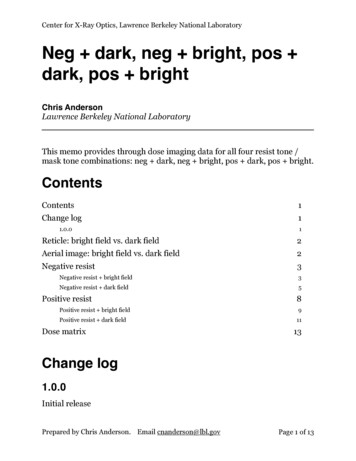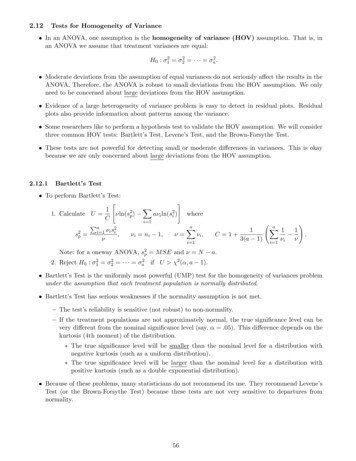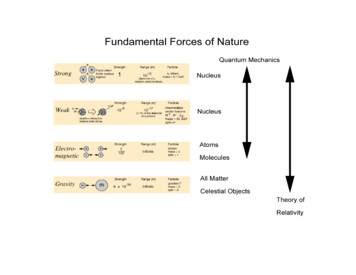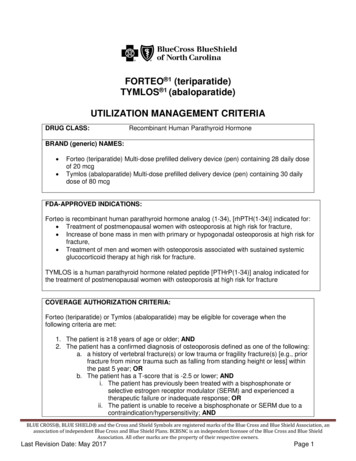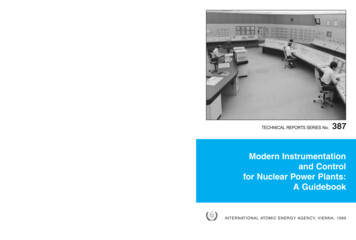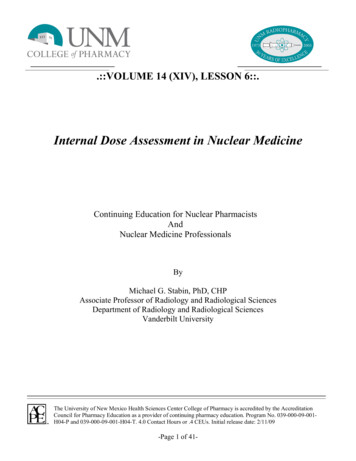
Transcription
.::VOLUME 14 (XIV), LESSON 6::.Internal Dose Assessment in Nuclear MedicineContinuing Education for Nuclear PharmacistsAndNuclear Medicine ProfessionalsByMichael G. Stabin, PhD, CHPAssociate Professor of Radiology and Radiological SciencesDepartment of Radiology and Radiological SciencesVanderbilt UniversityThe University of New Mexico Health Sciences Center College of Pharmacy is accredited by the AccreditationCouncil for Pharmacy Education as a provider of continuing pharmacy education. Program No. 039-000-09-001H04-P and 039-000-09-001-H04-T. 4.0 Contact Hours or .4 CEUs. Initial release date: 2/11/09-Page 1 of 41-
-- Intentionally left blank ---Page 2 of 41-
Instructions:Upon purchase of this Lesson, you will have gained access to the online site where this lesson and thecorresponding assessment are located. http://hsc.unm.edu/pharmacy/radiopharmacyCE/To receive a Statement of Credit you must:1. Review content2. Complete assessment, submit answers online and pass with a 70% (you will have 2 chances topass)3. Complete lesson evaluationOnce all requirements are met, a Statement of Credit will be available in your workspace. At any timeyou may "View the Certificate" and use the print command of your web browser to print thecompletion certificate for your records.NOTE: Please be aware that we can not provide you with the correct answers to questions you gotwrong. This would violate the rules and regulations for accreditation by ACPE. We can however, tellyou which questions you did receive wrong. You may contact the CE Administrator to request thisinformation.Disclosure:The Author does not hold a vested interest in or affiliation with any corporateorganization offeringfinancial support or grant monies for this continuing education activity, or any affiliation with anorganization whose philosophy could potentially bias the presentation.-Page 3 of 41-
Internal Dose Assessment in Nuclear MedicineByMichael G. Stabin, PhD, CHPEditor, CENPJeffrey Norenberg, MS, PharmD, BCNP, FASHP, FAPhAUNM College of PharmacyEditorial BoardStephen Dragotakes, RPh, BCNP, FAPhANeil Petry, RPh, MS, BCNP, FAPhAJames Ponto, MS, RPh, BCNP, FAPhATim Quinton, PharmD, MS, FAPhAS. Duann Vanderslice, RPh, BCNP, FAPhAJohn Yuen, PharmD, BCNPAdvisory BoardDave Abbott, RPh, BCNPMark Gurgone, BS, RPh.Vivian Loveless, PharmD BCNP, FAPhALisa Marmon, RPh, BCNPMichael Mosley, RPh, BCNPJanet Robertson, BS, RPh, BCNPBrantley Strickland, BCNPScott Knishka, RPh, BCNPDave Engstrom, PharmD, BCNPBrigette Nelson, MS, PharmD, BCNPSamuel Ernesto, RPh, MBADirector, CENPKristina Wittstrom, RPh, FAPhA, BCNPUNM College of PharmacyAdministrator, CE & Web PublisherChristina Muñoz, B.S.UNM College of PharmacyWhile the advice and information in this publication are believed to be true and accurate at the time of press, the author(s), editors, or thepublisher cannot accept any legal responsibility for any errors or omissions that may be made. The publisher makes no warranty,expressed or implied, with respect to the material contained herein.Copyright 2008University of New Mexico Health Sciences CenterPharmacy Continuing EducationAlbuquerque, New Mexico-Page 4 of 41-
INTERNAL DOSE ASSESSMENT IN NUCLEAR MEDICINESTATEMENT OF LEARNING OBJECTIVES:Upon completion of this course, participants will understand the current state of the art in internal dosemodels and methods and be able to perform basic internal dose calculations for diagnostic andtherapeutic radiopharmaceuticals, including some patient-specific modifications.-Page 5 of 41-
COURSE OUTLINERADIATION DOSE ASSESSMENT: INPUT DATA, METHODS AND MODELS. 7DOSE QUANTITIES AND UNITS . 8Relating Absorbed Doses to Biological Effects - Equivalent Dose . 11Relating Absorbed Doses to Biological Effects - Effective Dose . 12KINETIC PARAMETERS – CUMULATED ACTIVITY . 17DOSE CALCULATIONS . 18DOSIMETRY SYSTEMS . 20MIRD System . 21RADAR System. 21ABSORBED FRACTIONS AND DOSE CONVERSION FACTORS . 22INPUT DATA FOR INTERNAL DOSE CALCULATIONS . 24PRECLINICAL STUDIES. 25CLINICAL STUDIES . 25DATA ANALYSIS . 26Direct integration . 26Least Squares Analysis . 27Compartmental analysis . 27EXAMPLES . 28Animal Data Extrapolation . 28Numerical Integration of Extrapolated Animal Time-Activity Data Curve . 29Clinical Data Set. 30CONCLUSION AND SUMMARY . 32ASSESSMENT QUESTIONS . 33REFERENCES . 39-Page 6 of 41-
INTERNAL DOSE ASSESSMENT IN NUCLEAR MEDICINEMichael G. Stabin, PhD, CHPAssociate Professor of Radiology and Radiological SciencesDepartment of Radiology and Radiological SciencesVanderbilt UniversityRADIATION DOSE ASSESSMENT: INPUT DATA, METHODS AND MODELSIn any use of ionizing radiation, an analysis of the risks and benefits is needed to justify and optimizethe procedures involved. When radiopharmaceuticals are administered to patients to diagnose andevaluate disease or for therapeutic purposes, estimates of radiation dose to major organs and tissues ofthe body are required. Internal dose estimates are performed via calculations and the use of theoreticalmodels, as it is not possible to make direct measurements of the radiation doses received. Standardizedmodels of the human body and standardized models of radiopharmaceutical behavior in the body maybe used to characterize the radiation doses received by various tissues in the body. The use ofstandardized models and methods will result in calculations that are both traceable and reproducible.One must always bear in mind, however, that calculated dose estimates are applicable only given theassumptions employed in these standardized models and also are only as good as the input dataemployed in the calculations. In diagnostic applications, the broad generalization of doses to thenuclear medicine population for a particular patient group (e.g. adults, children, pregnant women) isusually acceptable. All input data have some associated uncertainty, and the calculated results willinclude the inherent uncertainty from the input data as well as those related to the application ofstandardized models of the body to a population of patients who may vary substantially in size, age,and other physical characteristics. In therapeutic applications, however, more attention to accuracy andprecision is needed, as with the higher doses likely to be encountered, we may approach some organthresholds for radiation damage, and we should employ more patient-individualized data and models,as possible.-Page 7 of 41-
Dose Quantities and UnitsThe principal quantity of interest to our calculations is ‘Absorbed Dose’ (D), which is defined as theenergy absorbed per unit mass of any material (i.e. not only human tissue):D dεdm(1)where dε is the mean energy imparted by ionizing radiation to matter in a volume element of mass dm.The units of absorbed dose are energy per unit mass, e.g. erg/g, J/kg, or others. Special units incommon use include the rad (equal to 100 erg/g) and the gray (Gy) (1 J/kg). The rad is being replacedby the SI unit value, the gray (Gy), which is numerically equal to 100 rad (i.e., 1 Gy 100 rad). Themultiple of the Gy most applicable to the exposures encountered in diagnostic applications ofradiopharmaceuticals is the milligray (mGy), which is equal to 0.001 Gy. In therapeutic applications innuclear medicine, doses in Gy may be more commonly discussed. Note, as an aside, that doses in ‘rad’or ‘gray’ never need to be given with a plural form; one may speak of 0.5 Gy or 3 Gy, the latter said as“three gray”, not “three grays”.The quantity ‘Activity’ is defined as the number of nuclear transformations per unit time occurring in agiven sample of radioactive material. The units are nuclear transformations/unit time. Special unitsinclude:curie (Ci) 3.7 x 1010 transformations/secbecquerel (Bq) 1 transformation/secNote: transformations/sec are commonly referred to as dps, standing for disintegrations per second ordecays per second.The radioactive decay constant (λ) is the rate constant for radioactive atoms undergoing spontaneousnuclear transformation. It is a first-order rate constant (i.e., the fraction of radioactive atomsundergoing nuclear transformation per time). Its units are inverse time, (e.g. h-1). The radioactive halflife is the time needed for one half of the atoms in a sample of radioactive material to undergotransformation. Mathematically the half-life is ln(2)/λ 0.693/λ, with units of time (hours (h), for-Page 8 of 41-
example). A radioactive material with initial activity A0 will decrease its activity with time accordingto the expression:λ(2)Plots of the activity of a radioactive substance as a function of time may be made on linear orlogarithmic graphs, as in Figure 1.A0AA0/2T1/2tA0A0/2ln(A)T1/2tFigure 1. Linear and semi-logarithmic plots of the activity of a radioactive substance as afunction of time, showing the radionuclide ‘half-life’.-Page 9 of 41-
Doses from radiopharmaceuticals are often given as absorbed dose per unit administered activity. Thisis convenient, in that different studies or different institutions may employ different quantities ofactivity for various studies using the same radiopharmaceutical. The principal units given mostcommonly are mGy/MBq, although sometimes traditional units of rad/mCi are provided as well (whenone performs all unit conversions, one can show that there are 3.7 rad/mCi or 1 mGy/MBq). Table 1shows example dose calculations for administration of 18FDG to an adult 1 .Table 1RADIATION DOSE ESTIMATES FOR 18FDGTarget OrganAdrenalsBladderBone surfacesBrainBreastsGall bladderGI-tract:StomachSmall IntestineColonUpper Large IntestineLower Large riesPancreasRed marrowSkinSpleenTestesThymusThyroidUterusRemaining organsEstimated Absorbed 0080.0110.0110.0120.0100.0180.012-Page 10 of 0670.041
Relating Absorbed Doses to Biological Effects - Equivalent DoseIt is often observed that all types of radiation do not produce the same effects at a given dose level(mGy). If a dose D’ of a given radiation type produces the same biological endpoint in a givenexperiment as a dose D of a defined ‘reference radiation’ (perhaps X-rays of a given kVp), we candefine a quantity called the Relative Biological Effectiveness (RBE) 2 :RBE DD'(4)So, for example, if a dose of 1 Gy of a reference radiation produces a particular cell survival level, butonly 0.1 Gy of another radiation produces the same level of cell killing, the RBE for this experimentwould be given as 10. RBE is closely related to the Linear Energy Transfer (LET) radiation (energyimparted to a medium per unit pathlength of the radiation track). High LET radiations generally havehigher RBEs (250 kVp X-rays are generally considered to be low LET radiation). The relationship ofthe two variables is not directly linear, but there is a positive correlation between RBE and LET, untilvery high LET values are reached, where “overkill” of cells causes the RBE to increase less quickly.The quantity equivalent dose (HT,R) has been defined to account for differences in the effectiveness ofdifferent types of radiation in producing biological damage:HT,R wR DT,R(5)where DT,R is the dose delivered by radiation type R averaged over a tissue or organ T and wR is theradiation weighting factor for radiation type R. The weighting factor wR is dimensionless, sofundamentally, the units of equivalent dose are the same as absorbed dose (energy/mass).Operationally, however, we distinguish this using the special units of the rem (which is the D(rad) xwR) and sievert (Sv) (equal to the D(Gy) x wR). As 1 Gy 100 rad, 1 Sv 100 rem. Like the units forabsorbed dose, the rem and sievert (Sv) are collective terms; one need not speak of “rems” and“sieverts”, although this may be heard in common speech and even observed in publications.Values of wR are very closely tied to RBE values, however, they are NOT exactly equal. Generally,conservative values of RBE were used to set the values assigned for wR values (also formerly called“quality factors”, some readers may recall). RBE values are highly dependent on the experimentalconditions (cell type, radiation type, radiation dose rate) and the biological endpoint defined for study-Page 11 of 41-
in which they were defined. Radiation weighting factors, on the other hand, are operational quantitiesto be applied to a type of radiation in all situations.Equivalent dose is defined for ANY kind of radiation, but ONLY in human tissue. The recommendedvalues of the radiation weighting factor have varied somewhat over the years, as evidence frombiological experiments has been given and interpreted. The current values recommended by theInternational Commission on Radiological Protection 3 are (note that values for neutrons are not given,as they are not often of interest in internal dose assessment):Table 2RADIATION WEIGHTING FACTORS CURRENTLYRECOMMENDED BY THE ICRPType of radiationwRPhotons, all energies1Electrons and muons1Protons and charged pions2Alpha particles, fission fragments, heavy ions20The weighting factor of 20 for alpha particles is reasonable for radiation protection purposes, but someradiobiological evidence indicates that this value may be too conservative for use inradiopharmaceutical therapy, and may be as low as five 4 or even one 5 . The contrary argument appliesto the use of Auger emitters, for which literature values indicate a range of potential RBEs greater than1, particularly if the emitters are closely associated with cellular DNA 6 . Clearly more investigation andguidance from regulatory and international advisory bodies is needed for the application of thesevalues to therapy with internal emitters.Relating Absorbed Doses to Biological Effects - Effective DoseThe International Commission on Radiological Protection (ICRP), in its 1979 description of radiationprotection quantities and limits for radiation workers 7 , defined a new dosimetry quantity, the effectivedose equivalent (He or EDE). The ICRP subsequently renamed this quantity effective dose (E) in1991 8 , and new weighting factors were given in ICRP Publication 1033. Certain organs or organsystems were assigned dimensionless weighting factors (Table 3), which are assumed to relate to theirdiffering radiosensitivity for expressing fatal cancers or genetic defects.-Page 12 of 41-
Table 3WEIGHTING FACTORS RECOMMENDED BY THE ICRPFOR CALCULATION OF THE EFFECTIVE DOSEOrganICRP 30 (1979) ICRP 60 (1991) ICRP 103 (2007)Gonads0.250.200.08Red 0.010.01Bone Surfaces0.030.010.01Brain0.01Salivary glands0.01Remainder0.300.050.12The assumed radiosensitivities were derived from the observed rates of expression of these effects invarious populations exposed to radiation. Multiplying an organ's dose equivalent by its assignedweighting factor gives a 'weighted dose equivalent'. The sum of weighted dose equivalents for a givenexposure to radiation is the effective dose:E H T wT(6)THere is an example calculation of the effective dose using the tissue weighting factors from ICRP 60and given individual organ equivalent doses (note that all weighting factors are not used, and thus donot sum to ies0.20Red Marrow0.12Bone Surfaces0.01Thyroid0.05TOTAL (Effective Dose)EquivalentDose (mSv)0.590.330.250.420.550.15Weighted DoseEquivalent (mSv)0.02950.001650.0500.05040.00550.00750.145The effective dose is meant to represent the equivalent dose that, if received uniformly by the wholebody, would result in the same total risk as that actually incurred by a given actual nonuniform-Page 13 of 41-
irradiation. It is entirely different from the equivalent dose that one might calculate for the 'wholebody', using dose conversion factors for the total body. 'Whole body' doses are not useful in nuclearmedicine applications, as all energy from the radiation deposited in the body (usually quitenonuniformly) is averaged over the mass of the whole body (70 kg). Thus, if a radiopharmaceuticalconcentrates heavily in a few organs, all of the energy absorbed by these (and other) organs is dividedby the mass of the whole body to obtain the ‘whole body’ dose. This quantity is not meaningful ininternal dose assessment, unless the radionuclide distribution is nearly uniform, as, for example, forintakes of 3H2O, or 137Cs. The goal of nuclear medicine is to administer compounds that selectivelyconcentrate in particular organs or regions of the body for diagnostic or therapeutic purposes, so‘whole body’ dose is not a descriptive or useful quantity to calculate. The following table summarizessome of the dose quantities of interest in nuclear medicine dosimetry:Table 4SUMMARY OF NUCLEAR MEDICINE DOSE QUANTITIESQuantityUnitsCommentsGy or SvDoses to all available organs and tissues inthe standardized phantoms should beroutinely reported.Individual organ dose(absorbed dose or equivalent dose)Maximum dose organGy or Sv(absorbed dose or equivalent dose)Whole body doseGy or Sv(absorbed dose or equivalent dose)Effective DoseSvThe individual organ that receives thehighest dose per unit activity administeredor per study should be considered in studydesign and execution.Useful only if all organs and tissues in thebody receive an approximately uniformdose. Rarely of value forradiopharmaceuticals. Most useful inexternal dose assessment.Risk weighted effective whole body dose.Gives the equivalent dose uniform to thewhole body that theoretically has the samerisk as the actual, nonuniform dose patternreceived.The use of the effective dose in nuclear medicine has been controversial. The MIRD Committee of theSociety of Nuclear Medicine has objected to the use of the effective dose quantity in nuclear medicine,due to the uncertainties involved and the fact that the quantity was derived for use with a radiationworker population 9 . Its use, however, is supported by the ICRP and routinely provided forradiopharmaceutical doses1. Also, NRC regulations for radiation dose limits to workers are specified in-Page 14 of 41-
terms of effective dose equivalent (i.e., 5 rem/yr effective dose equivalent) [reference: 10 CFR20.1201). For the doses in Table 1, the ICRP gives the effective dose as 0.019 mSv/MBq (0.070rem/mCi). One should recognize the limitations on the use of the ‘effective dose’: The quantity should never be used in situations involving radiation therapy, as it is related to theevaluation of stochastic risks from exposures involving low doses and dose rates. It should not be used to evaluate the risk to a given individual; its application is to populationsthat receive doses at these levels.If one accepts the quantity, with all of its inherent assumptions and uncertainties, however, it providessome useful features: As just noted, it allows direct comparison of different radiopharmaceuticals that may havecompletely different radiation dose patterns. For example, compare the use of 201Tl chloridewith 99mTc Sestamibi for use in myocardial perfusion imaging studies. There are manyvariables that enter into a discussion of which agent is preferable for these studies, and we willnot review all of them here. But just from a radiation dose standpoint, if one uses for example74 MBq (2 mCi) of 201Tl chloride, the two highest dose organs are the thyroid, which mayreceive about 40 mGy (4 rad) and the kidneys, which may receive about 30 mSv (3 rem) 10 . Onemight instead use 740 MBq (20 mCi) of 99mTc Sestamibi, in which case the two highest doseorgans are the gallbladder, which may receive about 29 mSv (2.9 rem) and the kidneys, whichmay receive about 27 mSv (2.7 rem) (rest patients) 11 . The dose to the kidneys is similar, but is40 mGy to the thyroid more acceptable than 29 mGy to the gallbladder? The effective doses for201Tl chloride is 11.5 mSv (1.15 rem) and for 99mTc Sestamibi is 6.7 mSv (0.67 rem). Sostrictly from a dose standpoint, the use of 99mTc Sestamibi appears more desirable, although thiswas not immediately obvious by looking at the highest dose organs. Effective doses from radiopharmaceuticals may be added to those received from otherprocedures outside of nuclear medicine. For example, if a typical value of an effective dose fora lumbar spine x-ray is 2.1 mSv (0.21 rem), and a subject has had two such exams recently andthen receives a 99mTc Sestamibi heart scan, the total effective dose is estimated as 6.7 (2 x2.1) 11 mSv (1.1 rem). A popular way to explain radiation risks in a simple way that many members of the public canunderstand is to express the dose in terms of equivalent years of exposure to backgroundradiation 12 . Estimates of background radiation dose rates vary, but if one chooses 3 mSv/year(300 mrem/year) as an example, then the 99mTc Sestamibi study discussed above may bethought of as equivalent in total risk to slightly more than 2 years of exposure to naturalbackground radiation. Also, radiation risk can be compared to the annual allowable radiationdose to a radiation worker (i.e., 5 rem effective dose equivalent). The 99mTc Sestamibi studydiscussed above may also be thought of as equivalent in total risk to 13 % of the annualexposure allowed for a radiation worker.-Page 15 of 41-
Kinetic Parameters – Effective half-timeAs discussed above, radioactive materials decay according to exponential processes:A(t ) A0 e λ t(7)Many materials are also cleared from the body or certain organs in the same way. We can thus developan equation in these cases for the reduction in the amount of a nonradioactive substance:X ( t ) X 0 e λb t(8)where X(t) the amount of the nonradioactive substance at time tX0 the initial amount of substance Xλb the biological disappearance constant 0.693/TbTb the biological half-time for removal.A biological half-time for removal is exactly analogous to a radioactive (or physical) half-life; i.e., it isthe time in which half of the remaining material is removed, but in this case only by biologicalprocesses. If we now consider a certain amount of radioactive material in the body that is being clearedfrom the body by an exponential process, two exponential processes will be involved in removing theactivity from the body - radioactive decay and biological disappearance. Because these decayconstants are essentially probabilities of removal per unit time, the disappearance constants for the twoprocesses can be added to give an "effective disappearance constant":λe λb λ pwhere(9)λe effective disappearance constantλp radioactive (physical) decay constantλb biological disappearance constantWe can also define an "effective half-time" equal to 0.693/λe, which is the time for half of the activityto be removed from the body or organ, by both physical decay and biological removal. It can be easilyshown that the effective half-time is related to the other biological and physical half-times by thefollowing relationship:Te Tb T pTb T p-Page 16 of 41-(10)
Note that the effective half-time for a compound will always be less than or equal to the shorter ofeither the biological or radiological half-time. As two processes are contributing to the removal of theelement, the action of the two together must act faster than either acting alone. Note also that to solvethe equation for effective half-time, the units for the biological and physical half-times must be thesame. Here are some examples.20 7 5.19 days20 77 7 3.5 days7 7Tb 7 days Tp 20 daysTeff Tb 7 days Tp 7 daysTeff(note – this is not a coincidence. Every time that the biological and physical half-times are the same,the effective half-time is exactly half of either value, because the value is (x x)/2x x/2)100 7 6.54 days100 710 9 7 7.00 days 910 7Tb 7 days Tp 100 daysTeff Tb 7 days Tp 109 daysTeffSo, as one half-time gets very long relative to the other, the effective half-time approaches the shorterof the two.Kinetic Parameters – Cumulated ActivityTotal dose over some period of integration (usually from the time of administration to infinity) requirescalculation of the time integral of the time-activity curve for all important organs. This quantity issometimes seen with the symbol Ã, as in Figure 2.ActivityÃTimeFigure 2. Generalized time-activity curve for an organ in thebody with uptake of a radiopharmaceutical.-Page 17 of 41-
Regardless of the shape of the time-activity curve, its integral, however obtained, will have units of thenumber of total nuclear transitions (activity, which is transitions per unit time, multiplied by time).Common units for activity are Bq or MBq, and time may be given in seconds or hours. One Bq-s isnumerically equal to one transformation (disintegration). For materials that cleared from the body or anorgan by exponential processes, the integral of the time-activity curve may be easily evaluated: 00 A A(t) dt A0 e-λ e t dt A0 1.443 A0 T eλe(11)where A0 is the initial activity in a given region. Effective half-time is a critical parameter in thedetermination of cumulated activity and cumulative dose.Dose CalculationsTo estimate absorbed dose in a given organ of the body, one must determine the amount of energydeposited per unit mass of the organ. This yields the quantity absorbed dose, when expressed in properunits, and can be extended to calculation of equivalent and effective dose if desired. We can develop ageneric equation for the absorbed dose rate in an organ by assigning numerical values to all quantitiesneeded to establish the energy deposited and the mass of the organ. Once we cite the radionuclideinvolved, we know the characteristic energies and abundances of the nuclide’s emissions. We mustknow the amount of activity in the organ, and one other factor that we will need is the fraction ofenergy released in the organ that is absorbed within the organ. This quantity is most often called theabsorbed fraction and is often represented by the symbol φ. For photons (gamma rays and X rays)some of the emitted energy will escape objects of the size and composition of interest to internaldosimetry (mostly soft tissue organs having diameters on the order of centimeters). For alphaemissions, electrons and beta particles, most of the energy considered to be absorbed, so we usuallyassume that the absorbed fraction is 1.0. Alphas, electrons, beta particles, and the like are usuallygrouped into a class of radiations referred to as ‘nonpenetrating emissions’, while X and gamma raysare cal
Internal Dose Assessment in Nuclear Medicine. Continuing Education for Nuclear Pharmacists . And . . Review content . 2. Complete assessment, submit answers online and pass with a 70% (you will have 2 chances to . can not provide you with the correct answers to questions you got wr

